Germ layers - Study guides, Class notes & Summaries
Looking for the best study guides, study notes and summaries about Germ layers? On this page you'll find 858 study documents about Germ layers.
Page 4 out of 858 results
Sort by
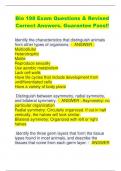
-
Bio 198 Exam Questions & Revised Correct Answers. Guarantee Pass!!
- Exam (elaborations) • 37 pages • 2024
-
- $11.34
- + learn more
Bio 198 Exam Questions & Revised Correct Answers. Guarantee Pass!! Identify the characteristics that distinguish animals from other types of organisms. - ANSWER : Multicellular Heterotrophic Motile Reproduce sexually Use aerobic metabolism Lack cell walls Have life cycles that include development from undifferentiated cells Have a variety of body plans Distinguish between asymmetry, radial symmetry, and bilateral symmetry. - ANSWER : Asymmetry: no particular organization Ra...
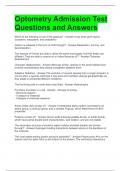
-
Optometry Admission Test Questions and Answers
- Exam (elaborations) • 51 pages • 2024
-
Available in package deal
-
- $12.49
- + learn more
Optometry Admission Test Questions and Answers Which of the following is true of the gastrula? - Answer-It has three germ layers (ectoderm, mesoderm, and endoderm) Carbon is released in the form of CO2 through? - Answer-Respiration, burning, and decomposition Two species of finches are able to utilize the same food supply, but their beaks are different. They are able to coexist on an island because of? - Answer-Character displacement Character displacement - Answer-Although similar, sp...
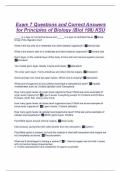
-
Exam 7 Questions and Correct Answers for Principles of Biology (Biol 198) KSU
- Exam (elaborations) • 29 pages • 2024
-
Available in package deal
-
- $11.99
- + learn more
_____ is a type of connective tissue and _____ is a type of epithelial tissue. Bone; lining of the digestive tract What is the top side of a vertebrate and other bilateral organisms? Dorsal side What is the bottom side of a vertebrate and other bilateral organisms? Ventral side Germ layer on the outside layer of the body. Forms skin and nervous system (nerves). Ectoderm The middle germ layer. Mostly muscle and bones. Mesoderm The inner germ layer. Forms intestines and other internal organs....
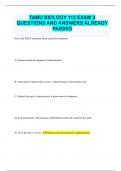
-
TAMU BIOLOGY 112 EXAM 3 QUESTIONS AND ANSWERS ALREADY PASSED
- Exam (elaborations) • 45 pages • 2024
- Available in package deal
-
- $11.49
- + learn more
TAMU BIOLOGY 112 EXAM 3 QUESTIONS AND ANSWERS ALREADY PASSED Select the TRUE statement about animal development: A.) Deuterostome development is indeterminate. B.) Mesoderm in protostomes arises as outpocketings of the primitive gut. C.) Radial cleavage is characteristic of protostome development. D) In deuterostomes, the blastopore ultimately becomes the mouth of the adult. E) All of the above are true. Deuterostome development is indeterminate. During embryogenesis o...
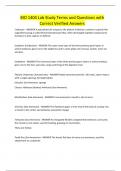
-
BIO 1404 Lab Study Terms and Questions with Correct Verified Answers
- Exam (elaborations) • 22 pages • 2024
-
- $12.94
- + learn more
Cnidocyte - ANSWER A specialized cell unique to the phylum Cnidarian; contains a capsule-like organelle housing a coiled thread (nematocyte) that, when discharged explodes outward and functions in prey capture or defense Ectoderm (Cnidarians) - ANSWER The outer most layer of the three primary germ layers in animal embryos; gives rise to the epidermis and in some phyla, the nervous system, inner ear and lens
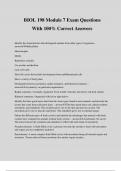
-
BIOL 198 Module 7 Exam Questions With 100% Correct Answers
- Exam (elaborations) • 18 pages • 2024
- Available in package deal
-
- $12.49
- + learn more
BIOL 198 Module 7 Exam Questions With 100% Correct Answers Identify the characteristics that distinguish animals from other types of organisms. - answerMulticellular Heterotrophic Motile Reproduce sexually Use aerobic metabolism Lack cell walls Have life cycles that include development from undifferentiated cells Have a variety of body plans Distinguish between asymmetry, radial symmetry, and bilateral symmetry. - answerAsymmetry: no particular organization Radial symmetry: Circular...
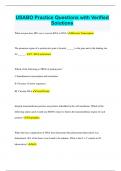
-
USABO Practice Questions with Verified Solutions
- Exam (elaborations) • 34 pages • 2024
-
Available in package deal
-
- $10.49
- + learn more
USABO Practice Questions with Verified Solutions What enzyme does HIV use to convert RNA to DNA? Reverse Transcriptase The promoter region of a prokaryotic gene is located ______ to the gene and is the binding site for ______. 5'...RNA polymerase Which of the following is TRUE of prokaryotes? I. Simultaneous transcription and translation II. Presence of intron sequences III. Circular DNA I and III only Integral transmembrane proteins are proteins imbedded in the cell membrane...
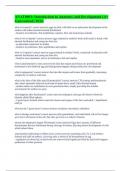
-
ANAT0001: Introduction to Anatomy and Development (A+ Guaranteed) 2024.
- Exam (elaborations) • 27 pages • 2024
-
- $12.99
- + learn more
what is oviparity? correct answers eggs are laid, with little or no embryonic development in the mother with either internal/external fertilisation - found in invertebrates, fish amphibians, reptiles, birts and monotreme animals what is ovoviviparity? correct answers eggs retained in mother's body until ready to hatch, with internal fertilisation and young are born lice - no placental connection to mother - found in invertebrates, fish, amphibians and reptiles what is viviparity? corre...
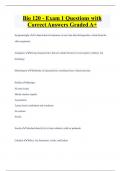
-
Bio 120 - Exam 1 Questions with Correct Answers Graded A+
- Exam (elaborations) • 39 pages • 2024
- Available in package deal
-
- $12.99
- + learn more
Bio 120 - Exam 1 Questions with Correct Answers Graded A+ Synapomorphy A shared derived character or trait state that distinguishes a clade from the other organisms. Analagous Having characteristics that are similar because of convergent evolution, not homology. Homologous Similarity in characteristics resulting from a shared ancestry. Porifera Sponges No true tissues Mostly marine, aquatic Asymmetric 2 germ layers (endoderm and ectoderm) No coelom Sessile Sessile Attached direc...
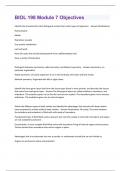
-
BIOL 198 Module 7 Objectives Questions & Answers Already Passed!!
- Exam (elaborations) • 19 pages • 2024
- Available in package deal
-
- $6.79
- + learn more
Identify the characteristics that distinguish animals from other types of organisms. - Answer-Multicellular Heterotrophic Motile Reproduce sexually Use aerobic metabolism Lack cell walls Have life cycles that include development from undifferentiated cells Have a variety of body plans Distinguish between asymmetry, radial symmetry, and bilateral symmetry. - Answer-Asymmetry: no particular organization Radial symmetry: Circularly organized. If cut in half vertically, the halves will loo...

How did he do that? By selling his study resources on Stuvia. Try it yourself! Discover all about earning on Stuvia


